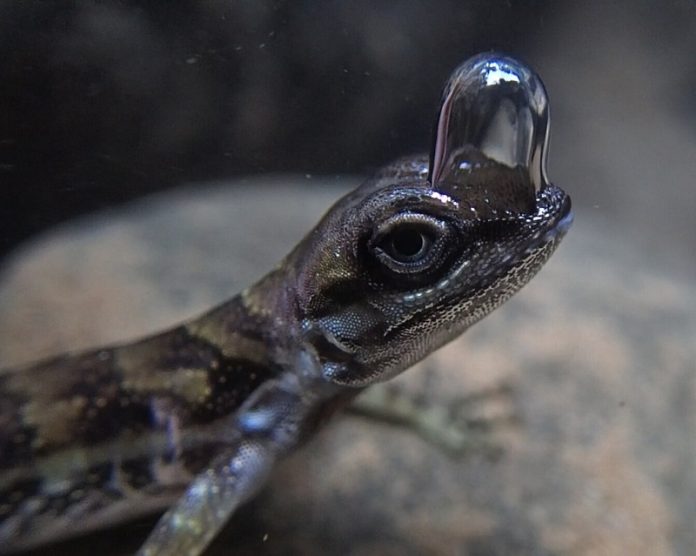
In a fascinating discovery, scientists have found that a species of small, semi-aquatic lizard from Costa Rica has developed a unique way to survive underwater: it creates a special air bubble over its nostrils to breathe.
This clever trick allows the lizard to stay hidden from predators for long periods underwater, making it one of nature’s smallest and most resourceful “scuba divers.”
The research, conducted by Lindsey Swierk, an assistant research professor of biological sciences at Binghamton University, State University of New York, focuses on water anoles—a type of lizard found in the tropical forests of southern Costa Rica.
These lizards are known to dive underwater when they feel threatened by predators like birds and snakes. Once underwater, they use a bubble over their heads to breathe, allowing them to stay submerged for much longer than they could otherwise.
“We knew that these lizards could stay underwater for a long time, and we suspected they were getting oxygen from the bubble of air,” said Swierk.
“But we weren’t sure if the bubble actually helped them breathe better or if it was just a byproduct of their skin’s properties.”
To find out if the bubble had a real function, Swierk and her team applied a substance to the lizards’ skin that would stop the bubbles from forming.
The study, published in Biology Letters, compared these lizards to a control group that could form bubbles normally.
The results were clear: lizards with intact bubbles could stay underwater 32% longer than those without bubbles.
“This is a significant finding because it’s the first experiment to prove that the bubbles are truly helpful. The bubbles allow the lizards to stay underwater longer, which is crucial for their survival,” explained Swierk.
Water anoles are often preyed upon by various forest animals, which makes their ability to escape underwater vital. “Anoles are like the chicken nuggets of the forest—everything wants to eat them,” said Swierk. By diving into water and staying still, the lizards can avoid being seen by predators. They are well camouflaged underwater and can remain submerged for at least 20 minutes, possibly even longer.
The next step for Swierk and her team is to explore whether the lizards’ bubble acts like a “physical gill,” a mechanism found in some insects. Insects use air bubbles to extract oxygen from water, which sustains them while submerged.
While the lizards are likely too large to rely solely on this oxygen, Swierk’s graduate student, Alexandra Martin, is investigating whether the bubble might still help the lizards stay underwater longer by changing the oxygen levels in the water around them.
This research opens up exciting possibilities for understanding more about how animals use bubbles and could even lead to bio-inspired materials. Swierk is also thrilled by the chance to learn more about this newly discovered behavior.
“I’ve had people tell me how much they love scuba diving and freediving, and they’re fascinated by how animals might do the same thing,” Swierk said. “This is a great opportunity to get people excited about science by connecting what they enjoy doing with what’s evolved in nature. Even with animals that seem ordinary, there’s always something new to discover.”
This discovery of “scuba-diving” lizards adds a new chapter to our understanding of how animals adapt to survive, showing once again that nature is full of surprises.



